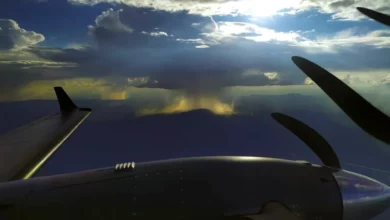
The Arctic ice cap is melting faster than ever before, threatening to push so much fresh water into the North Atlantic that it could disrupt how the ocean regulates global temperatures, a prominent oceanographer has warned.
As the head of a 40-member climate mission to the Arctic aboard the Canadian Coast Guard ice breaker Amundsen, Belgian researcher Roger Francois is concerned about how the pace of climate change may affect the future of deep water pools and currents, and how this imbalance may worsen the effects of global warming.
Over the course of the past two million years, temperatures have risen and fallen in 100,000-year cycles, with a sheet of ice forming over the Arctic cap each time followed by a rapid melt, he told AFP.
The last warming occurred between 20,000 and 15,000 years ago, and led at that time to a rise in sea level of 130 meters (425 feet).
"This really is the trend with the thaws in Greenland and Antarctica," said Francois, who is a professor at the University of British Columbia in Vancouver.
"The biggest difference with today is the time scale. It has never been faster."
Each cycle is marked by an increase in carbon in the atmosphere. At the last change, the rate of carbon dioxide in the air increased from 180 parts per million to 280 ppm over 5,000 years. Until the Industrial Revolution, the level remained at 280 ppm, and since then it has skyrocketed to more than 400 ppm in 2015, he explained.
"If we continue this way, and that's what seems to be happening, we'll end up by the end of the century with rates we have not had since the days of the dinosaurs, the Mesozoic Age," with 1,000 ppm, Francois warned.
'Feedbacks'
The last deglaciation, or disappearance of ice from an area that was formerly covered by it, was followed by a much longer than usual period of climate stability, which allowed Homo sapiens to flourish.
"Our civilization, as we know it, is actually a direct result of climate change," said Francois.
At the heart of this climate are "deep water" masses that are created in the North Atlantic off Greenland when surface seawater evaporates and cools as wind blows over it, resulting in increased salinity. The remaining water becomes heavier and more dense and sinks into deep basins.
The water then flows southward along deep abyssal plains and back, creating currents that are "a major mechanism for transporting heat from the equator to the poles," said Francois.
With the melting of the ice cap, dilution in the sea of icebergs made of fresh water "lowers salinity, and makes more difficult the formation of deep water masses," he explained.
But if the heat transfer between the equator and the poles is interrupted because this deep water circulation is broken, then "high latitudes become much colder," he said.
Such a scenario already happened during the last global warming.
"It was still colder in early deglaciation than during the Ice Age in northern Europe in particular," said the oceans researcher.
Changing of the deep water formation is only one of several climate phenomena that can amplify the effects of global warming. These so-called "feedbacks" can cause climate change to spiral out of control.
An oft-cited example of this is the melting of sea ice due to warming exposing darker seas that absorb heat instead of reflecting sunshine, which hastens warming.
"We do not know all the feedbacks involved in the change, hence our concern," says Francois.
"The whole system is so complex, it is not something that can be experimented on. We're talking about processes occurring on a global scale. Just a small detail forgotten can lead to different conclusions."




